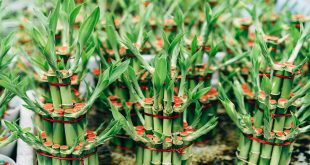Lucky bamboo, also known as dracaena sanderiana, is a popular houseplant known for its striking appearance and believed to bring good luck and positive energy. Despite its misleading name, lucky bamboo is not actually bamboo but belongs to the genus dracaena.
One of the most common questions people have about lucky bamboo is whether it grows best in soil or water. The answer to this question is relatively simple: lucky bamboo prefers to grow in water rather than soil. In fact, growing lucky bamboo in water has become a popular choice for many gardeners and plant enthusiasts due to its low maintenance and ability to flourish in water alone. In this article, we will explore the reasons why lucky bamboo grows best in water and provide some helpful tips for successfully growing it.
Pros And Cons Of Growing Lucky Bamboo In Soil
Lucky bamboo, with its vibrant green color and elegant stems, makes for a beautiful indoor plant. When it comes to growing this popular ornamental plant, one question often arises: does lucky bamboo grow best in soil or water? While both methods have their own merits, this section will focus on the advantages and disadvantages of growing lucky bamboo in soil.
So let’s dive into the factors that make soil a favorable growth medium for lucky bamboo.
Advantages Of Using Soil As A Growth Medium:
- Nutrient-rich environment: Soil provides a natural source of nutrients for lucky bamboo, promoting healthier and more vigorous growth. It contains essential minerals and organic matter that nourish the plant, helping it thrive.
- Better root development: Growing lucky bamboo in soil allows for better root development compared to water. The soil acts as a supportive base, providing stability and anchorage to the plant. This results in stronger and more resilient roots, ensuring long-term growth and vitality.
Disadvantages Of Using Soil:
- Risk of overwatering: The main concern with using soil as a growth medium is the risk of overwatering. Lucky bamboo is susceptible to root rot if it sits in waterlogged soil for an extended period. Care must be taken to monitor the moisture levels and ensure proper drainage to avoid this issue.
- Soil quality and drainage issues: The quality of the soil used is crucial for the success of growing lucky bamboo. Poor-quality soil or soil with inadequate drainage can lead to waterlogging, root suffocation, and ultimately, the decline of the plant. Choosing the right soil mix and providing adequate drainage is essential for healthy growth.
Growing lucky bamboo in soil can offer certain advantages, such as a nutrient-rich environment and better root development. However, it comes with the risk of overwatering and requires careful attention to soil quality and drainage. By understanding and addressing these factors, you can create an optimal growing environment for your lucky bamboo plant.
Pros And Cons Of Growing Lucky Bamboo In Water
Lucky bamboo, with its vibrant green leaves and unique twisting stems, is a popular choice for both home and office décor. One of the key decisions when growing lucky bamboo is whether to use soil or water as the growth medium.
In this section, we will explore the advantages and disadvantages of using water to grow lucky bamboo plants.
Advantages Of Using Water As A Growth Medium:
- Low maintenance requirements: Growing lucky bamboo in water eliminates the need for regular soil fertilization and drainage. This makes it a convenient choice for those with busy schedules or little experience in plant care.
- Easy to monitor water levels: With lucky bamboo rooted in water, it is effortless to check and maintain the appropriate water levels. This allows for better control over the plant’s hydration, ensuring its optimal growth.
Disadvantages Of Using Water:
- Limited nutrient availability: While water can provide sufficient hydration for lucky bamboo, it lacks essential nutrients found in soil. This can result in slower growth and less vibrant foliage.
- Risk of root rot: Without proper care and attention, lucky bamboo roots may be at risk of developing root rot in water. This can occur if the water becomes stagnant or if the plant is exposed to excessive moisture for an extended period. Regular water changes and proper ventilation are crucial to avoid this issue.
As you can see, growing lucky bamboo in water offers low maintenance requirements and makes it easy to monitor water levels. However, it is important to note the limited nutrient availability and the risk of root rot if not properly managed.
Consider these factors when deciding whether to grow your lucky bamboo in water or soil, ensuring the health and longevity of your plant.
Factors To Consider When Choosing Growth Medium For Lucky Bamboo
Lucky bamboo, also known as dracaena sanderiana, is a popular plant that is believed to bring good luck and positive energy. But when it comes to growing this plant, many people wonder whether it should be cultivated in soil or water.
The growth medium for lucky bamboo plays a crucial role in its overall health and development. So, let’s explore the factors you should consider when choosing the right growth medium for your lucky bamboo.
Lighting Requirements
- Lucky bamboo enjoys bright, indirect light. It thrives when placed near a window where it can receive moderate to bright light, but avoiding direct sunlight.
- If you choose to grow lucky bamboo in water, make sure to place it in a glass container that allows light to penetrate. This helps the plant perform photosynthesis effectively.
Maintenance And Care
- Lucky bamboo grown in soil requires regular watering to keep the soil moist, but not waterlogged. Ensure the soil has good drainage to prevent waterlogging.
- Watered lucky bamboo should have its water changed every two weeks to maintain freshness and avoid microbial growth.
- Both soil and water-grown lucky bamboo benefit from regular misting, which helps to increase humidity levels.
Aesthetic Preferences
- Growing lucky bamboo in soil offers a more traditional and natural look, allowing you to choose from a wide range of decorative pots.
- On the other hand, growing lucky bamboo in water provides an elegant and minimalist appearance, as the roots are visible and can be showcased in decorative vases or containers.
Growth Speed And Overall Health
- Lucky bamboo grown in water tends to grow faster compared to those in soil. The additional nutrients available in the water contribute to accelerated growth.
- However, soil-grown lucky bamboo may have a more robust root system, leading to a healthier and more stable plant.
- Monitoring and maintaining proper water levels are essential for healthy growth in both soil and water.
Considering these factors will help you determine the ideal growth medium that suits your lifestyle, aesthetic preferences, and the needs of your lucky bamboo plant. Whether you choose to grow it in soil or water, providing the right lighting, maintenance, and care will ensure its longevity and success.
Tips For Successful Lucky Bamboo Growth In Soil
Lucky bamboo is not only a beautiful decorative plant, but it is also believed to bring good luck and positive energy into homes and office spaces. While many may argue that lucky bamboo grows best in water, it can also thrive in soil if given the proper care and attention.
Here are some valuable tips to ensure successful growth of lucky bamboo in soil:
Selecting the right soil type:
- Lucky bamboo prefers well-draining soil. Opt for a well-balanced potting mix that retains enough moisture while allowing excess water to drain freely.
- Avoid heavy soils that can lead to waterlogging and root rot. Look for a mixture containing a balanced combination of organic matter, such as peat moss or compost, to provide nutrients to the plant.
Providing proper drainage:
- Drainage is crucial for the health of lucky bamboo when grown in soil. Choose a pot with drainage holes to prevent standing water and allow excess moisture to escape.
- Place a layer of small pebbles at the bottom of the pot before adding the soil. This helps promote drainage and prevents the roots from sitting in water.
Watering and fertilizing techniques:
- Avoid overwatering. Check the soil moisture level by touching it with your finger. If the top inch of soil feels dry, it’s time to water the plant.
- Water the lucky bamboo thoroughly, ensuring that the soil is evenly moist but not soaked. Empty any excess water from the saucer to prevent water accumulation.
- Fertilize the plant every two to three months with a balanced liquid fertilizer specifically formulated for lucky bamboo. Dilute the fertilizer according to the package instructions and apply it directly to the soil.
By following these essential tips, you can promote successful growth of lucky bamboo in soil and enjoy its aesthetic appeal as well as the positive energy it brings into your living spaces.
Tips For Successful Lucky Bamboo Growth In Water
Lucky bamboo, with its attractive foliage and low-maintenance nature, has become a popular choice for indoor plants. One question that often arises is whether lucky bamboo grows best in soil or water. While it can thrive in both mediums, growing lucky bamboo in water can be an interesting and rewarding experience.
In this section, we will explore some tips for successful lucky bamboo growth in water.
Choosing The Right Container:
- Select a container that is tall enough to hold the bamboo stalks and allows the roots to grow freely.
- Clear glass or plastic containers are ideal, as they allow you to observe the root growth.
- Avoid containers with narrow openings that might hinder the placement of the stalks.
Adding Essential Nutrients:
- Lucky bamboo can thrive solely in water, but it requires certain nutrients to support its growth.
- Use filtered or bottled water to avoid chlorine or other harmful chemicals.
- Add liquid fertilizer specifically formulated for lucky bamboo, following the manufacturer’s instructions.
- Feed the plant every two to four weeks to provide it with the necessary nutrients.
Monitoring Water Quality And Changing Regularly:
- Keep an eye on the water quality to ensure the health of your lucky bamboo.
- If the water becomes cloudy or emits an unpleasant odor, it is a sign of bacterial growth that can harm the plant.
- Change the water regularly, approximately once every week or two, to maintain a clean and healthy environment for the plant.
- Rinse the roots gently before placing them back in fresh water to remove any accumulated debris.
By following these tips for successful lucky bamboo growth in water, you can create a stunning display of this popular indoor plant. Remember to choose the right container, provide essential nutrients, and monitor and change the water regularly to keep your lucky bamboo thriving.
With a little care and attention, you can enjoy the beauty of healthy lucky bamboo in your home or office.
Comparing Growth Rates: Soil Vs. Water
Lucky bamboo, with its vibrant green stalks and graceful appearance, has become a popular indoor plant choice. But when it comes to growing this plant, one question that often arises is whether it thrives best in soil or water. In this blog post, we will dive into the topic and explore the growth rates of lucky bamboo in both mediums.
By examining the factors influencing growth rate and delving into case studies and experiments, we can gain a better understanding of how the growth medium impacts the progression of this beloved plant. So let’s jump right in and explore the world of lucky bamboo’s growth habits.
Factors Influencing Growth Rate:
- Light intensity: Lucky bamboo requires bright but indirect light for optimal growth. Insufficient light can retard growth, regardless of the growth medium.
- Water quality: Using distilled or purified water helps prevent the buildup of minerals that may inhibit growth.
- Nutrient availability: Lucky bamboo requires essential nutrients like nitrogen, phosphorus, and potassium, which can be supplied through fertilizers.
- Moisture levels: Both soil and water need to maintain appropriate moisture levels to facilitate healthy growth.
Case Studies And Experiments:
- A study conducted by researchers found that lucky bamboo grown in soil exhibited slower initial growth compared to those grown in water. However, after an extended period, the overall growth rate of lucky bamboo in soil surpassed that of water-grown plants.
- Another experiment compared the overall growth and health of lucky bamboo in both soil and water. Results showed that while water-grown plants initially grew at a faster rate, they displayed more signs of yellowing and root rot compared to those in soil.
The growth medium plays a crucial role in the development of lucky bamboo. While water may provide faster initial growth, soil-grown plants tend to show stronger and healthier growth in the long run. It is important to consider the specific requirements of lucky bamboo, such as light intensity, water quality, and nutrient availability, to create an optimal growing environment.
By understanding these factors and learning from case studies and experiments, you can ensure the successful growth of your lucky bamboo, whether you choose soil or water as the growth medium.
Frequently Asked Questions Of Does Lucky Bamboo Grow Best In Soil Or Water?
Can Lucky Bamboo Be Planted In Soil?
Yes, lucky bamboo can be planted in a well-draining soil mix. However, it’s important to avoid overwatering and provide adequate drainage to prevent root rot.
Can Lucky Bamboo Grow Without Soil?
Absolutely! Lucky bamboo can thrive in water as well. Simply place the bamboo stalks in a container with enough water to cover the roots, and change the water every two weeks to keep it fresh.
Which Method Is Better: Soil Or Water?
Both methods are suitable for growing lucky bamboo. Soil provides more stability and nutrients, while water allows you to appreciate the beauty of the root system. Ultimately, it’s a matter of personal preference and convenience.
How Often Should I Water My Lucky Bamboo In Soil?
Water your lucky bamboo planted in soil when the top inch of soil feels dry to the touch. This typically requires watering every 1-2 weeks, but may vary depending on factors like temperature and humidity levels.
Can I Convert My Lucky Bamboo From Soil To Water?
Yes, you can easily convert your lucky bamboo from soil to water. Gently remove the plant from the pot, rinse off the soil, trim any damaged roots, and place it in a water-filled container. Ensure the roots are fully submerged.
What Are The Benefits Of Growing Lucky Bamboo In Water?
Growing lucky bamboo in water provides a beautiful and aesthetic look, as it showcases the plant’s intricate root system. Additionally, water can help maintain a higher humidity level, benefiting the growth of the plant. Just remember to change the water every two weeks to avoid stagnation.
Conclusion
Based on the information provided, it is clear that lucky bamboo can be grown successfully both in soil and water. However, each method has its own set of advantages and considerations. Growing lucky bamboo in water requires less maintenance and provides a unique aesthetic appeal.
It also allows for easy observation of the root system and can be beneficial for those who do not have access to appropriate soil conditions. On the other hand, growing lucky bamboo in soil allows for a more natural and stable growth, providing the plant with essential nutrients.
It also creates a better support system for the bamboo stalks, reducing the risk of toppling over. Ultimately, the choice between soil and water depends on personal preference and individual circumstances. Whether you choose to grow lucky bamboo in soil or water, both methods can lead to healthy and thriving plants that bring luck and positive energy to your home or office space.
 GardenXpert Garden Advice Blog
GardenXpert Garden Advice Blog





